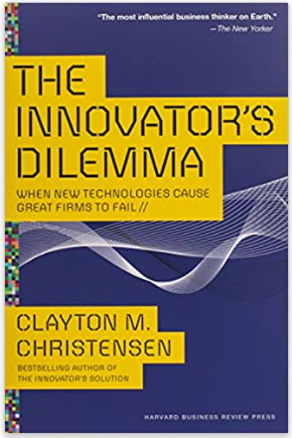The Reading Room

The Innovator’s Dilemma: When new technologies cause great firms to fail
Clayton M Christensen
Published: 1997
This book seeks to answer the question, why do some well-managed, successful companies fail, and often when they are at the top of the game?
Although the author’s thesis is over twenty years old, I was fascinated to understand his thinking since many management teams of today’s leading businesses may be falling into the same trap as their predecessors.
The central theme of this book is the author’s analysis, understanding and conclusions as to why some highly regarded and successful companies ultimately fail. At first glance Clayton Christensen observes no pattern to explain this reversal in fortune, before concluding a common theme does in fact emerge.
Thus, Christensen expounds the belief that there is something “about the way that decisions are made” in successful organisations that sow the seeds of eventual failure.
To test his theory Christensen digs into the hard disk drive industry. This is a data rich business which over the years has experienced the development of companies and technologies that emerged, matured and declined, in quick time. Common to this sector’s rapid evolution was the failure by the incumbent to manage disruptive newcomers betting on change.
This caught my attention immediately. As a professional investor grappling to understand the implications of the digital revolution on today’s successful companies, were there lessons here I could pick up to help me in my struggle?
So why do companies often underestimate the disruptor at their peril?
One of the answers lies in the incumbent’s tendency to misread the market. For although the disruptor’s product offered attractive new features, smaller perhaps and easier to use, in the initial stages its performance failed to stack up, as feedback by sales teams and customer surveys.
The lack of initial customer interest, combined with higher upfront costs and possibly some hubris, increased the opportunity for new players to fill the void.
Interestingly many of the new innovator companies were formed by disgruntled employees of the established players, using market experience, persistence, and better tech to scope for a new market to dominate. Working off a low base, small incremental volumes move the needle and encourage further entrepreneurial activity. In the case of the hard disk, drives moved from 8-inch drives to 5.5inch to still smaller 3.5-inch enabling the market to shift from mini frame computers to desktops, laptops and now notebooks.
Christensen then goes on to test the applicability of his theory to other industries.
A similar story plays out in the excavator industry. In the beginning hydraulic excavators were shunned owing to inferior load carrying capacity. Likewise, examples are presented for integrated steel plants, which eventually floundered in the face of mini mill technology. More recently the discount retailers’ model has thrived over that of the department store which now feels outdated. The same goes for the ink jet printer over the DeskJet. All make fascinating reading, and inspire me to think more deeply about what this means for my portfolio and how I might best approach management in order to gauge their disruption risk.
In the latter part of the book, the author suggests sensible ways for incumbent managers to deal with the challenge of fending off the disruptor.
As there is no clear market and its characteristic keeps changing as new users emerge, he suggests creating a new entity, with its own processes, has flexibility and gets it fair share of resource.
Chirstensen suggests the best way for the incumbents to manage this risk is to create an autonomous entity within the incumbent organisation with the financial support and creative freedom to compete as a disruptor without the Company forgoing financial control.
There is much in the book which is instantly relatable to the current challenges faced by digital disruption. It is an engaging and thought provoking read for any business manager or professional investor looking to learn from the mistakes of the past.
Gaurav Narain
January 2022
The information contained above and in other entries in the Ocean Dial Book Review Series is intended for general information and entertainment purposes only, and should not be relied upon in making, or refraining from making, any investment decisions. No information provided herein should or can be taken to constitute any form of advice or recommendation as to the merits of any investment decision. You should take independent advice from a suitably qualified investment adviser before making any investment decisions.
The CEO Factory: Management Lessons from Hindustan Unilever
Published: 2019, Juggernaut Books
For six decades Hindustan Unilever has remained among India’s top five most valuable companies. No other Corporation in the world has done so well for so long. For the first time comes a book that decodes how this great business works – from a director of the company who has spent his whole career there.
Seven Decades of Independent India: Ideas and Reflections
Published: 2022, Penguin Books India
Has democracy in India fulfilled the aspirations of its people? Have institutions delivered? Have public policies succeeded in making substantial differences to living standards? Is the country secure on its external borders? Would the country become an economic powerhouse? And can India be a leading power in the years ahead?
Ikigai – The Japanese Secret to a Long and Healthy Life
Published: 2016, Cornerstone
We all have an ikigai. It’s the Japanese word for ‘a reason to live’ or ‘a reason to jump out of bed in the morning’. It’s the place where your needs, desires, ambitions, and satisfaction meet. A place of balance. Small wonder that finding your ikigai is closely linked to living longer.


